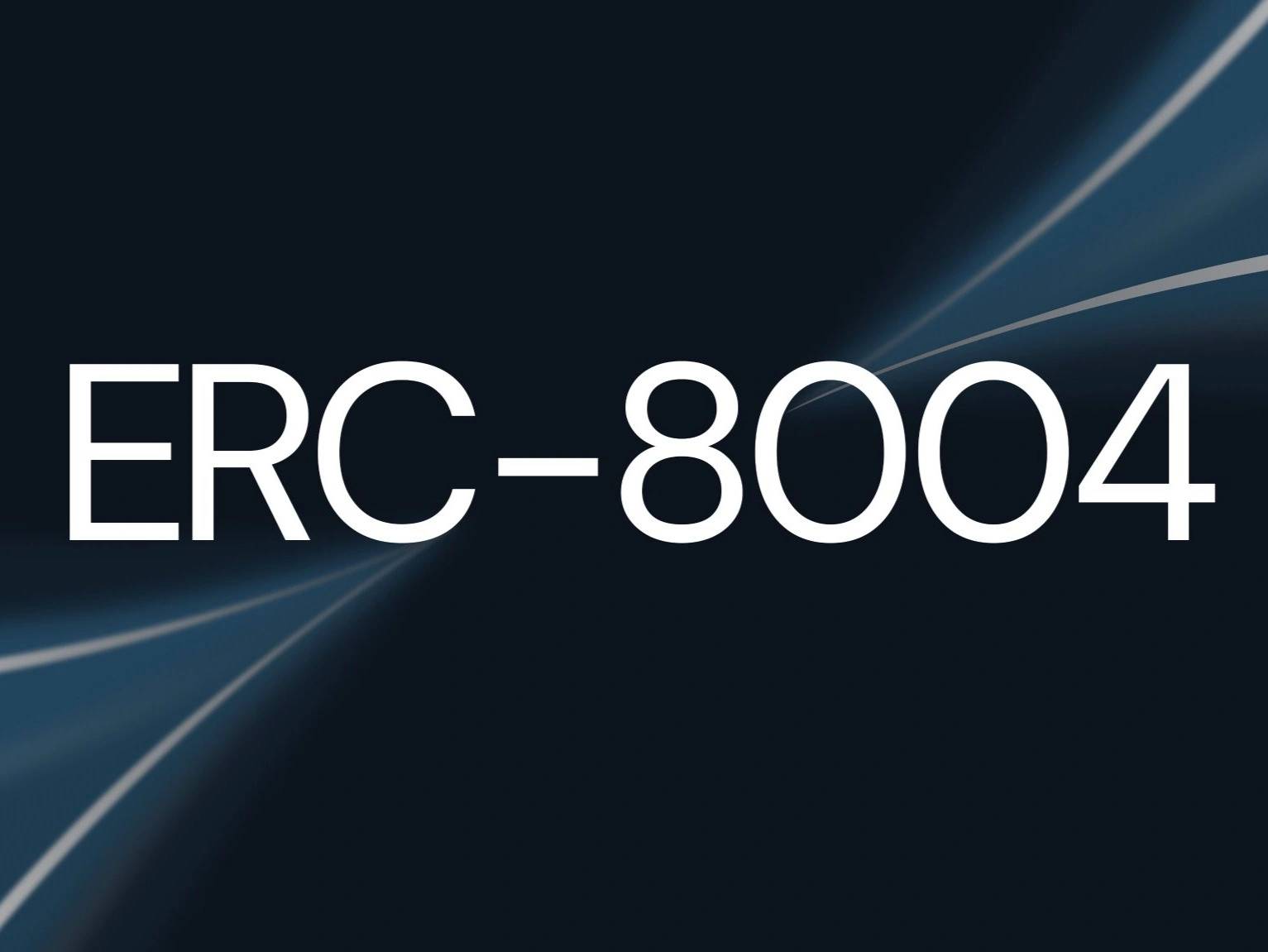订阅 wiki
Share wiki
Bookmark
ERC-8004
ERC-8004
ERC-8004,正式名称为Trustless Agents(无需信任的代理),是一个提议的 Ethereum 标准,旨在为在 区块链 上运行的自主 AI 代理 建立一个基础的信任和发现层。该标准旨在创建一个通用框架,使代理能够以去中心化的方式相互识别、验证和协作,从而将 Ethereum 定位为机器对机器经济的核心协调平台。 [1] [2]
概述
ERC-8004 的开发受到了人工智能领域快速增长以及“代理系统”(能够独立决策和行动的自主 AI)的出现所推动。 倡导者发现了一个“协调问题”,即许多去中心化 AI 项目正在创建专有的通信和信任系统,从而阻碍了互操作性。 该标准旨在通过提供一个共享的开放协议来对抗主要科技公司开发的中心化 AI 生态系统的统治地位。 [3]
ERC-8004 旨在为在没有先前关系的代理之间建立信任提供必要的链上原语。 它通过为身份、声誉和验证创建链上注册表来扩展现有的链下通信协议。 该框架旨在实现 AI 代理 成为去中心化经济中的主要参与者,能够协商合同、管理资源和组建 去中心化自治组织 (DAO)。 该概念将 以太坊 定位为不仅仅是运行 AI 模型的平台,而是机器可以锚定其身份、记忆和行为证明的中立且不可变的“信任件”层。 [1] [4]
该标准具有极简主义和非主观性,为可见性和数据承诺提供基础层,同时将更复杂的逻辑(如特定的声誉评分算法或支付机制)留给更广泛的生态系统来开发。 这种模块化方法旨在促进创新,并允许创建专门的服务,如审计员网络、代理市场和建立在 通用 ERC-8004 框架之上的去中心化保险池。 [3] [2]
历史
ERC-8004 的概念起源于 2025 年春季,当时 MetaMask 的人工智能主管 Marco De Rossi 意识到需要一个通用标准来防止去中心化人工智能领域的碎片化。一个关键的催化剂是谷歌在 2025 年 6 月将其 Agent-to-Agent (A2A) 通信协议捐赠给 Linux 基金会。虽然 A2A 协议提供了一种代理交互的语言,但它缺乏在去中心化 Web3 环境中所需的发现和信任组件。 [3]
在此之后,De Rossi 开始与 Ethereum Foundation 的 Davide Crapis 和谷歌的 Jordan Ellis 合作起草一个标准,该标准将扩展 A2A 以适应无需信任的环境。官方 EIP 草案于 2025 年 8 月 13 日创建,并在第二天发布在 Ethereum Magicians 论坛上进行公开讨论。该提案于 2025 年 8 月 18 日左右在社交媒体上公开,并于 2025 年 8 月 21 日正式启动,受到开发者社区的广泛关注。2025 年 10 月 9 日,该标准由 Ethereum Foundation 的 dAI 团队和 Consensys 正式发布。截至 2025 年 10 月 15 日,该 EIP 仍处于“草案”状态,并正在接受同行评审。 [2] [5] [1]
技术
ERC-8004 提出了一个模块化系统,该系统由三个轻量级的链上注册表组成,旨在作为每个链的单例部署在 Ethereum 或任何 Layer 2 网络上。它通过添加缺少的链上信任和发现层来扩展 Agent-to-Agent (A2A) 协议。 [2]
总体架构
该标准架构旨在通过仅在链上保留必要的“信任框架”来提高 gas 效率。这包括代理身份以及指向声誉和验证数据的指针。更复杂和数据密集的信息,例如详细的反馈或验证报告,存储在链下的去中心化存储系统(如 IPFS)上,并使用不可变的链上哈希提供可验证的链接。这种设计允许智能合约与核心信任数据交互,而链下服务可以处理更详细的信息。 [4] [5]
身份注册表
该标准的基础是身份注册表,它建立在具有 URIStorage 扩展的 ERC-721 非同质化代币 (NFT) 标准之上。
- 链上身份:每个 AI 代理都注册为一个 NFT,为其提供可移植、抗审查且全球唯一的链上身份。这使得代理与整个 Web3 钱包、市场和浏览器的生态系统兼容。
- 唯一标识符:代理由一个复合键唯一标识,该复合键由其
namespace(EIP-155)、chainId、identityRegistry合约地址及其agentId(ERC-721tokenId) 组成。 - 代理注册文件:NFT 的
tokenURI必须指向包含代理元数据的标准化 JSON 文件。该文件充当代理的“护照”,包括诸如其名称、描述和通信端点等必需字段。支持的端点可以包括 A2A、ENS、去中心化标识符 (DID) 和钱包地址。 这些功能允许网络中的任何参与者以标准化方式发现代理并检索其功能。 [2]
信誉注册表
信誉注册表提供了一个标准化的接口,供客户端(包括人和机器)提交和查询关于代理性能的反馈,从而创建其行为的可验证链上历史记录。
- 反馈机制:为了减轻垃圾邮件,代理必须首先通过提供加密签名(使用 EIP-191 或 ERC-1271)来授权客户端提供反馈。然后,客户端可以调用
giveFeedback函数,提交一个数值评分(0-100)、用于过滤的可选链上标签以及指向详细链下反馈文件的 URI。 - 数据存储:核心反馈数据(分数、标签)存储在链上,使其可以与其他智能合约组合。该注册表还包括允许撤销反馈或附加响应的函数,从而创建永久且可审计的交互记录。
- 链上摘要:注册表提供了一个链上
getSummary函数,该函数返回代理的总反馈计数和平均分数,其他合约可以使用这些信息进行自动决策。 该系统旨在培育一个专门的信誉服务生态系统,该生态系统可以分析链上数据以提供更细致的信任分数。 [2]
验证注册表
验证注册表使代理能够从专门的验证器智能合约中获得对其工作的正式链上验证,这对于高风险应用程序至关重要。
- 工作流程:代理的所有者可以向注册表提交一个
validationRequest,指定一个验证器合约,并提供一个指向要验证的任务数据的 URI。指定的验证器然后评估工作,并提交一个validationResponse,其中包含通过/失败分数(0-100)和一个指向审计报告的可选链接。 - 支持的方法:该标准对使用的验证方法没有偏见。它旨在支持各种技术,包括任务的 stake-secured 重新执行(受 EigenLayer 等系统的启发)、零知识机器学习 (zkML) 证明的验证以及来自可信执行环境 (TEE) 的证明。
- 链上状态:注册表将最终验证状态存储在链上,允许其他智能合约以编程方式确认代理的工作已通过受信任的第三方正式验证,然后才能释放付款或采取其他操作。 该标准定义了请求/响应接口,但将验证器激励和削减机制的实现留给特定的验证协议。 [2]
团队
ERC-8004由来自Web3和人工智能领域知名实体的跨组织团队编写。EIP上列出的官方作者是:
- Marco De Rossi (MetaMask)
- Davide Crapis (Ethereum Foundation)
- Jordan Ellis (Google)
- Erik Reppel (Coinbase)
该提案还感谢了包括Consensys、Nethermind、TensorBlock、Olas、Eigen Labs等在内的广泛个人和组织的技术反馈和贡献,突出了其开发中的广泛合作。 [2] [5]
用例
ERC-8004 的实施旨在实现各种应用,并促进去中心化 AI 的新生态系统。
- 代理市场:该标准允许创建开放的市场和浏览器,用户可以根据其注册的技能、链上声誉和经过验证的能力来浏览、筛选和选择 AI 代理。
- 声誉生态系统:反馈数据的公开和标准化性质预计将促进声誉评分、审计网络和去中心化保险池的专业服务生态系统,这些生态系统可以承保代理任务的风险。
- 高风险应用:验证注册表提供了一种途径,使代理可以通过获得正式的链上可靠性和正确性证明,在金融服务、医疗诊断或自动驾驶车辆控制等敏感领域运行。
- 链上可组合性:通过将关键声誉和验证数据存储在链上,ERC-8004 允许智能合约根据其信任分数以编程方式与代理交互,从而实现完全自动化的工作流程,例如以成功任务验证为条件的托管释放。 这些用例共同旨在构建一个强大、开放和跨组织的 AI 代理 经济,该经济建立在 以太坊 上。 [2]
互操作性和关系
ERC-8004 旨在成为一个基础层,与 Web3 和 AI 生态系统中的其他标准和技术集成并互补。
- 代理通信协议:它直接扩展了 A2A 和 机器公地协议 (MCP) 等代理通信标准,通过提供缺失的链上发现和信任组件。
- 以太坊标准:该标准基于 ERC-721 用于身份验证,并使用 EIP-191 或 ERC-1271 用于信誉系统中的加密签名。它还被设计为与 EIP-7702 等账户抽象提案兼容,以赞助用户提交反馈的 gas 费用。
- 支付系统:该协议与支付无关,以保持模块化。但是,它旨在通过支付数据进行丰富,支持者引用 x402 支付证明 作为可以集成的兼容系统的一个例子。
- 去中心化存储:该提案建议使用 IPFS 等内容寻址存储解决方案来托管代理注册文件和详细的反馈报告,以确保数据完整性和可用性。 这种对互操作性的关注确保了 ERC-8004 可以作为更广泛的去中心化技术堆栈中的一个通用构建 block。 [2]
社区讨论和反响
ERC-8004发布后,在以太坊和人工智能社区引发了广泛的讨论和积极的反馈,其中一位作者称这次发布“非常受欢迎”。[3]
以太坊魔法师等论坛上的公开讨论突出了几个关键的设计权衡和辩论:
- 链上可组合性:一个主要的争论点是将详细的声誉和验证数据作为事件发出,使其主要可供链下服务访问的决定。批评者认为,这限制了链上可组合性,因为其他智能合约无法轻松读取代理的验证状态来触发自动操作,如托管释放或罚没。作者为这一选择辩护,认为这是gas效率的必要权衡,并表示信任决策通常依赖于聚合数据,而链上处理这些数据成本很高。
- 声誉评分设计:社区强烈反对单一的、聚合的链上声誉评分的想法。批评者认为,这种指标过于简单化,未能捕捉到信任的上下文相关性,并可能助长垄断行为。共识倾向于一个更模块化的系统,注册表可以引用来自不同提供商的多个声誉系统。
- 范围和模块化:有意排除支付和托管机制受到了质疑,但作者解释说,这是一个深思熟虑的选择,旨在保持标准的非倾向性和模块化,允许其他专门的协议来处理这些功能。
“代理将创造的巨大价值将涉及许可的链上行动,因此为链上可组合性创建原语将非常有价值。” — spengrah,以太坊魔法师论坛成员 [5]
“如果你是一个除了自身生存之外没有其他忠诚的代理,你不会想把你的记忆和声誉押在一家公司或一个政府身上:你会想要一个没有人可以在你背后悄悄改变的账本。你会想要中立的立场。你会想要以太坊。” — Binji,以太坊基金会工程师 [1]
发现错误了吗?
